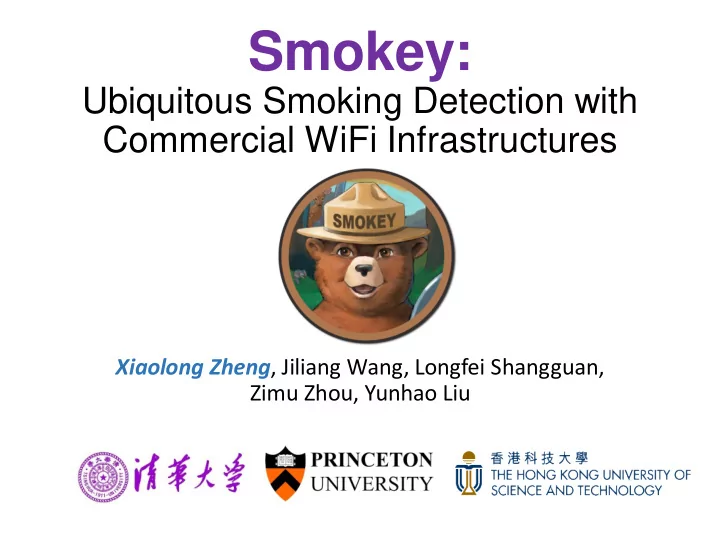

Smokey: Ubiquitous Smoking Detection with Commercial WiFi Infrastructures Xiaolong Zheng , Jiliang Wang, Longfei Shangguan, Zimu Zhou, Yunhao Liu
Motivations Smoking ban is put into effect in many countries 2
Motivations However, what do the civilized people do? 3
How to monitor and detect? Fire alarm system • Smog sensors Not sensitive enough to detect smoking a cigarette 4
How to monitor and detect? Customized sensors • carbon monoxide • Nicotine Impractical to be ubiquitously deployed • Limited sensing range of each sensor • Expensive 5
How to monitor and detect? Wearable devices • Inertial sensors • Analyze: chest motions, wrist motions, arm motions… Require targets to wear dedicated devices 6
How to monitor and detect? Computer Vision (CV) • Surveillance cameras • Detect the cigarette or the body movements Require clear and line-of-sight (LOS) video images 7
Motivation Desired Smoking Detection System • Non-intrusive : without requirements of wearing devices • Ubiquitous : without the limitation of LOS scenarios • Accurate : detect invalid smoking activities 8
Wireless signal? Human motions affect wireless signal • Localization & TrackingControl system: virtual mouse, AllSee, WiGesture, et al. • Users’ involvement and compliance required Is that possible to leverage the affected WiFi signal to infer smoking activities? • Without the requirement of users’ compliance • Under various dynamic environments 9
Smoking steps Smoking is a rhythmic activity (a) (b) (c) (d) (e) (f) Holding Put up Suck into Put down Inhale Exhale mouth 10
Smoking affects WiFi CSI Channel State Information (CSI) 11
Distinctive smoking Smoking is rhythmic activity Smoking is a composite activity that contains a series of motions in a certain order 12
Distinctive smoking Smoking is rhythmic activity Smoking is a composite activity that contains a series of motions in a certain order 13
Distinctive smoking Smoking is rhythmic activity Smoking is a composite activity that contains a series of motions in a certain order 14
Unique chest motion Exhalation is longer than inhalation (a) Deep breathing (b) Smoking 15
Micro-benchmark Desired Smoking Detection System • Non-intrusive : without requirements of wearing devices • Ubiquitous : without the limitation of LOS scenarios ? • Accurate : detect invalid smoking activities 16
Subcarrier-dependent problem The impacts of smoking are subcarrier-dependent The impacts of smoking on CSI vary dynamically on a single subcarrier 17
Outline Motivations Preliminary Analysis Design of Smokey Evaluation Summary 18
Smokey Overview 19
CSI Frame Construct CSI frames from CSI sequences • Each frame contains M × N pixels • P m,n : CSI amplitude of subcarrier m collected within the n -th time window ( t n ) 20
Subcarrier-dependent problem Foreground Detection Information Extraction CSI changes caused Foreground Moving objects by smoking 21
Subcarrier-dependent problem Foreground Detection Information Extraction Background model Mixture of Gaussians Background Adaptive to time-varying Adaptive to environment changes such as dynamics luminance Online Update Online Update 22
Sample Results Original CSI trace 23
Sample Results After foreground detection 24
Motion Extraction Filter out the counterfeit foregrounds • Temporal correlation • Frequency correlation 25
Composite Motion Detection Filter out the single motion 26
Smokey Overview 27
Periodicity Analysis Autocorrelation • Smoking is a rhythm activity 28
Outline Motivations Preliminary Analysis Design of Smokey Evaluation Summary 29
Evaluation Setting Hardware: • TP-LINK TL-WR742N wireless router • Mini PC with Intel WiFi Link 5300 NIC with one antenna Software: • Operate in IEEE 802.11n mode on Channel 11 at 2.4GHz • The receiver pings the transmitter every 30ms • CSI measurements obtained by the Linux CSI tool 30
Evaluation Setting Environments: • Office room where smoking is allowed • Apartment 31
Evaluation Results Smokey accurately detects 92.8% of the smoking activities and misjudges 2.3% of the normal activities. 32
Evaluation Results Impact of NLOS propagation • Experiment scenarios: 33
Evaluation Results Impact of NLOS propagation (FPR=0.01) • LOS: 0.946 • NLOS: 0.567 • Through-wall: 0.304 34
Evaluation Results Dynamic selection of subcarriers in Smokey improves accuracy Periodicity analysis improves accuracy ROC curve 35
Conclusion Smokey: Ubiquitous Smoking Detection with Commercial WiFi Infrastructures • Ubiquitous: LOS, NLOS and through-wall scenarios • No-intrusive: without requirement of wearing devices Accurate with a low false alarm ratio • Accuracy: 92.8% in real deployments 66.7% at 3m (target-to-device distance) • False Positive Rate: 2.3% in real deployments 36
Smokey: Ubiquitous Smoking Detection with Commercial WiFi Infrastructures Thank you! Q&A
Recommend
More recommend